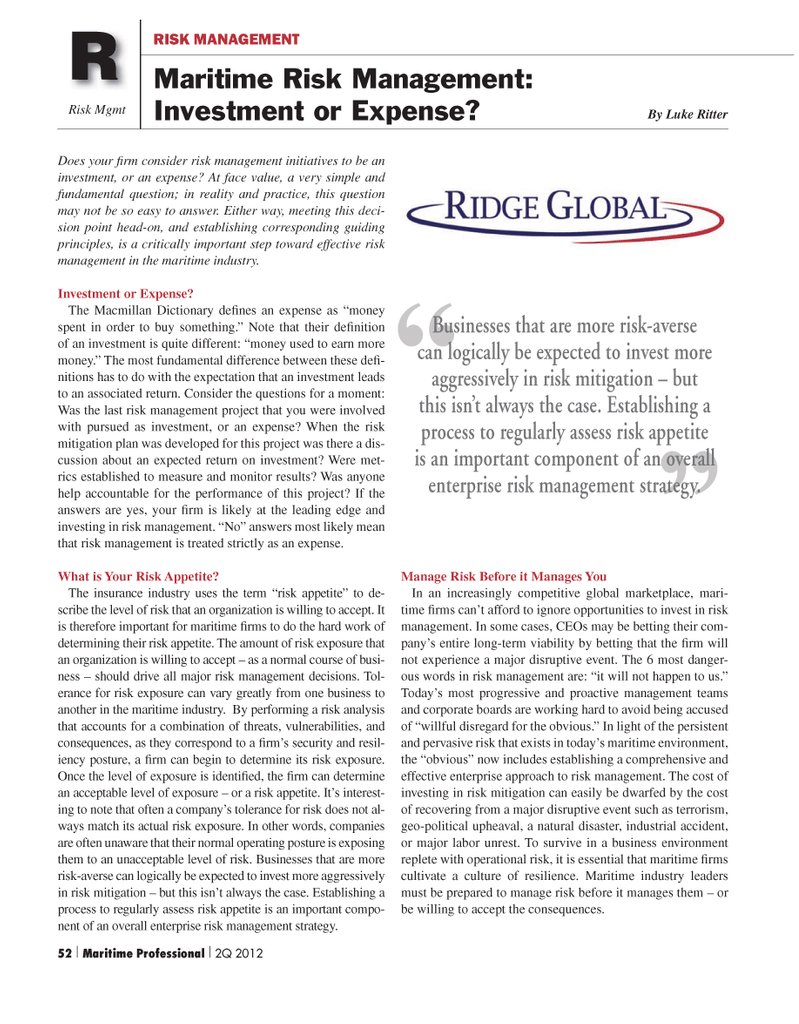
Page 52: of Maritime Logistics Professional Magazine (Q2 2012)
Maritime Risk
Read this page in Pdf, Flash or Html5 edition of Q2 2012 Maritime Logistics Professional Magazine
Risk Mgmt
RISK MANAGEMENT
Maritime Risk Management:
Investment or Expense?
R
By Luke Ritter
Does your fi rm consider risk management initiatives to be an investment, or an expense? At face value, a very simple and fundamental question; in reality and practice, this question may not be so easy to answer. Either way, meeting this deci- sion point head-on, and establishing corresponding guiding principles, is a critically important step toward effective risk management in the maritime industry.
Investment or Expense?
The Macmillan Dictionary defi nes an expense as “money spent in order to buy something.” Note that their defi nition of an investment is quite different: “money used to earn more money.” The most fundamental difference between these defi - nitions has to do with the expectation that an investment leads to an associated return. Consider the questions for a moment:
Was the last risk management project that you were involved with pursued as investment, or an expense? When the risk mitigation plan was developed for this project was there a dis- cussion about an expected return on investment? Were met- rics established to measure and monitor results? Was anyone help accountable for the performance of this project? If the answers are yes, your fi rm is likely at the leading edge and investing in risk management. “No” answers most likely mean that risk management is treated strictly as an expense.
What is Your Risk Appetite?
The insurance industry uses the term “risk appetite” to de- scribe the level of risk that an organization is willing to accept. It is therefore important for maritime fi rms to do the hard work of determining their risk appetite. The amount of risk exposure that an organization is willing to accept – as a normal course of busi- ness – should drive all major risk management decisions. Tol- erance for risk exposure can vary greatly from one business to another in the maritime industry. By performing a risk analysis that accounts for a combination of threats, vulnerabilities, and consequences, as they correspond to a fi rm’s security and resil- iency posture, a fi rm can begin to determine its risk exposure.
Once the level of exposure is identifi ed, the fi rm can determine an acceptable level of exposure – or a risk appetite. It’s interest- ing to note that often a company’s tolerance for risk does not al- ways match its actual risk exposure. In other words, companies are often unaware that their normal operating posture is exposing them to an unacceptable level of risk. Businesses that are more risk-averse can logically be expected to invest more aggressively in risk mitigation – but this isn’t always the case. Establishing a process to regularly assess risk appetite is an important compo- nent of an overall enterprise risk management strategy.
Manage Risk Before it Manages You
In an increasingly competitive global marketplace, mari- time fi rms can’t afford to ignore opportunities to invest in risk management. In some cases, CEOs may be betting their com- pany’s entire long-term viability by betting that the fi rm will not experience a major disruptive event. The 6 most danger- ous words in risk management are: “it will not happen to us.”
Today’s most progressive and proactive management teams and corporate boards are working hard to avoid being accused of “willful disregard for the obvious.” In light of the persistent and pervasive risk that exists in today’s maritime environment, the “obvious” now includes establishing a comprehensive and effective enterprise approach to risk management. The cost of investing in risk mitigation can easily be dwarfed by the cost of recovering from a major disruptive event such as terrorism, geo-political upheaval, a natural disaster, industrial accident, or major labor unrest. To survive in a business environment replete with operational risk, it is essential that maritime fi rms cultivate a culture of resilience. Maritime industry leaders must be prepared to manage risk before it manages them – or be willing to accept the consequences. ” “
Businesses that are more risk-averse can logically be expected to invest more aggressively in risk mitigation – but this isn’t always the case. Establishing a process to regularly assess risk appetite is an important component of an overall enterprise risk management strategy. 52 | Maritime Professional | 2Q 2012
MP #2 50-64 NEW STYLES.indd 52 5/8/2012 10:41:44 AM

 51
51

 53
53
